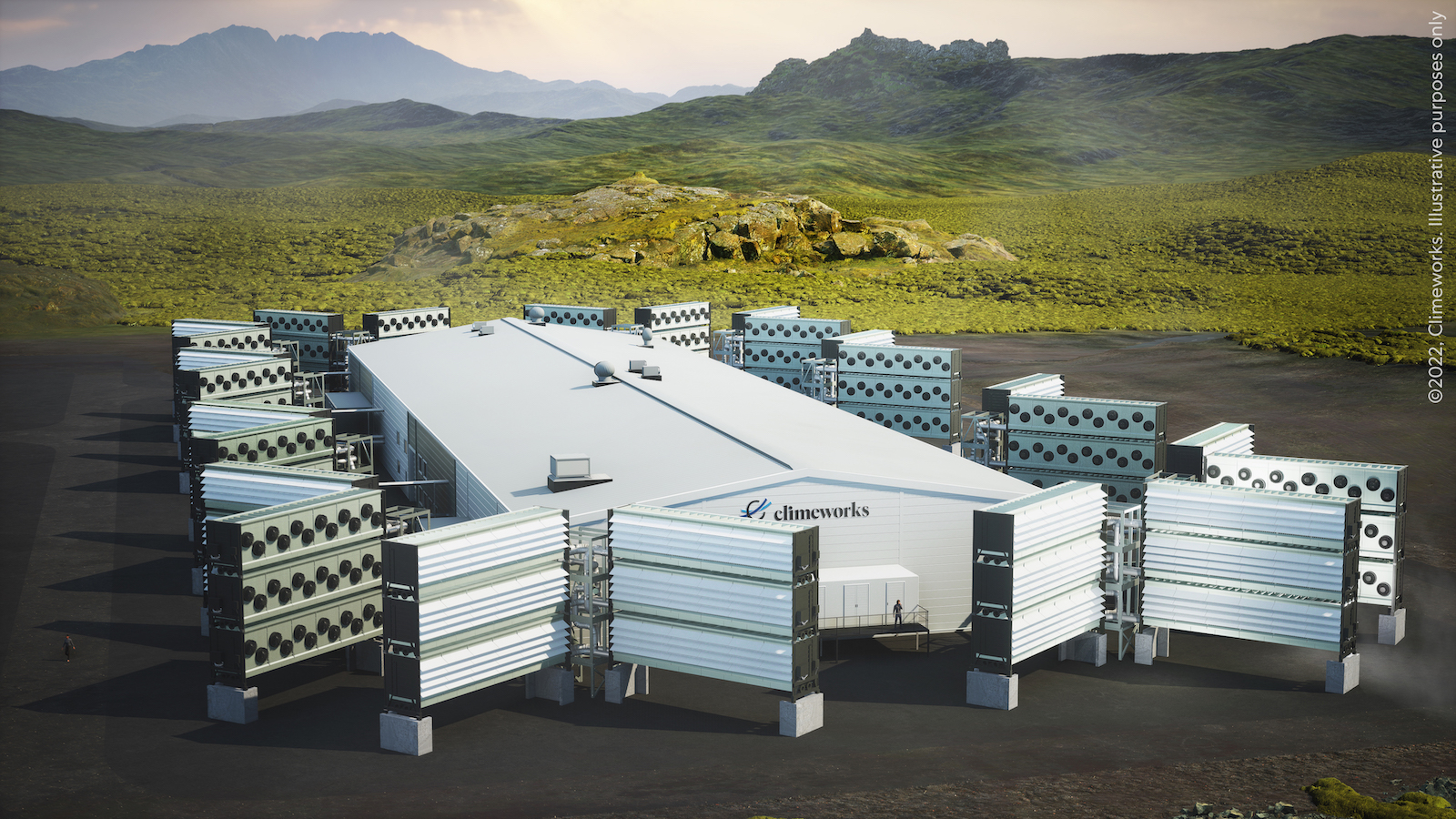Last fall, an emerging climate solution hit a milestone when the Swiss company Climeworks switched on its “Orca” plant, an array of fans and filters that capture carbon dioxide directly from the air. Built in Iceland, it is the largest plant of its kind in the world, designed to filter 4,000 metric tons of carbon dioxide from the air each year so it can be permanently stored underground.
Orca was only the beginning for Climeworks. In order for these kinds of “direct air capture” facilities to become a meaningful tool for limiting climate change, they will need to suck up many times that amount of carbon. This week, the company broke ground on “Mammoth,” another plant in Iceland designed to capture 36,000 metric tons of carbon dioxide annually. As with Orca, Climeworks is teaming up with a company called Carbfix that will pump the CO2 underground, where it will react with and bind to the subsurface rock in a matter of years.
Direct air capture plants and other methods for removing carbon from the atmosphere have become “unavoidable” in the fight to stabilize the climate, according to the United Nations’ climate body. The world must cut fossil fuels from the electric grid, cars, and homes. But carbon removal can counterbalance the emissions that are more challenging to cut, like those from agriculture and flying. It can also be deployed to mop up past emissions that are already warming the planet.
As Climeworks learns how to go bigger, a groundswell of new direct air capture companies are sprouting up in its wake. On Wednesday, the financial tech company Stripe, which was an early supporter of Climeworks, announced that it is spending $2.4 million to buy carbon removal from six startups. Three are pursuing different forms of direct air capture. It is the first purchase facilitated by Frontier, an initiative backed by Stripe, tech behemoths Meta and Alphabet, the e-commerce platform Shopify, and the consulting firm McKinsey that has committed $925 million to buying carbon removal over the next eight years.

There’s increasing demand for carbon removal from the corporate world. Climeworks’ customers, who pay the company to remove carbon in order to offset their own emissions, include Stripe and other tech companies like Microsoft, the insurance giant Swiss Re, and the jewelry company Swarovski, among others. Climeworks’ offsets are expensive, ranging between $600 and $1,200 per metric ton of CO2 removed. But they have proven attractive because the company’s carbon removal process is permanent and easy to measure. Cheaper offsets, like those that come from planting trees, only store carbon temporarily, since trees are vulnerable to drought, disease, and fire. And many nature-based carbon offsets have been based on faulty accounting.
But there are few other companies as far along as Climeworks that can deliver carbon removal that’s measurable and long-lasting. Frontier was formed to help other solutions scale up to meet the growing interest from buyers. “There is a significant amount of customer demand that’s made it into the field, we’re starting to see promising new companies get to the starting line,” said Nan Ransohoff, head of climate at Stripe. “We’re going to need to see a lot more of both of those.”
Ransohoff said that some of Frontier’s funds, including the $2.4 million announced this week, may never actually result in tons of carbon getting sucked out of the atmosphere. Instead, they will go to companies with promising ideas that may or may not pan out. Because the field is so nascent, they want to help “get a number of companies to the starting line,” she said. (But if any of this week’s purchases are fulfilled, and the companies hit certain technical milestones, Stripe has committed to spending up to an additional $5.4 million to buy more.)
The amount of carbon removal the world may ultimately want or need is debated, but estimates range from 1.5 billion metric tons per year to 20 billion. That means Mammoth’s 36,000 tons per year aren’t going to do much for the climate. Plants like Orca and Mammoth are best viewed as demonstration projects that are helping Climeworks incrementally scale up.
But after Mammoth is built and booted up, which is expected to take 18 to 24 months, Climeworks plans to go even bigger with a facility that can capture roughly 500,000 metric tons, co-founder Christoph Gebald told Reuters. The company’s goal is to be able to capture 1 billion metric tons across its facilities by 2050.
An important challenge for scaling up direct air capture is the enormous amount of energy and heat required to separate particles of CO2 from the air. Mammoth and Orca are strategically located near a geothermal plant that delivers both renewable electricity and heat. But while geothermal energy is bountiful in Iceland, it’s not available everywhere, and electricity alone may not be able to create the high heat needed for certain direct air capture processes. If the heat comes from burning natural gas or other fossil fuels, the climate benefits of carbon removal could be erased.
When Stripe solicited proposals for this round of funding, it found that an increasing number of direct air capture companies are trying to avoid this issue. One of the companies it funded this week, AspiraDAC of Australia, is building a modular system combining solar panels with a process that requires only low-temperature heat. Another, RepAir from Israel, is working on a process that can be powered by renewable energy and does not require heat at all. That being said, direct air capture plants can only be powered by renewable energy if there’s enough renewable energy to go around.
In addition to improving the energy efficiency of direct air capture projects, Ransohoff said, “We need to make sure that there are enough renewable projects on the grid to support these technologies.”
Editor’s note: Climeworks is an advertiser with Grist. Advertisers have no role in Grist’s editorial decisions.



